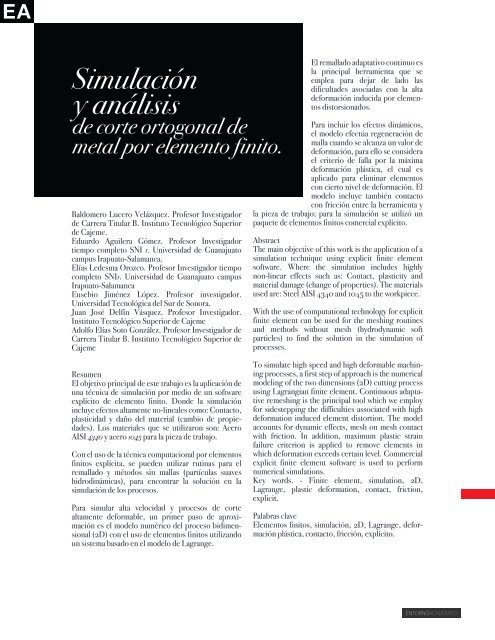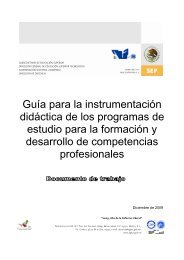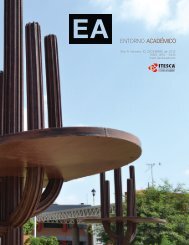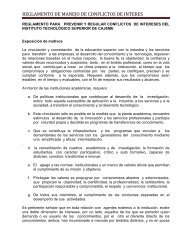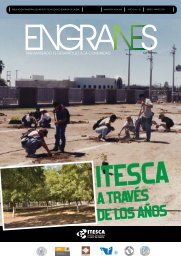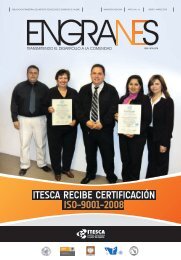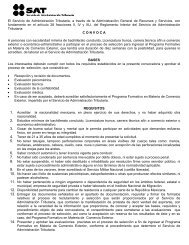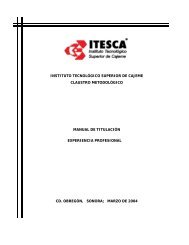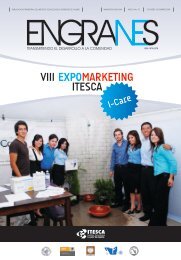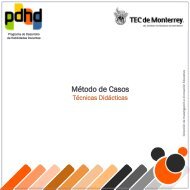Número 9 - Instituto Tecnológico Superior de Cajeme
Número 9 - Instituto Tecnológico Superior de Cajeme
Número 9 - Instituto Tecnológico Superior de Cajeme
You also want an ePaper? Increase the reach of your titles
YUMPU automatically turns print PDFs into web optimized ePapers that Google loves.
Simulación<br />
y análisis<br />
<strong>de</strong> corte ortogonal <strong>de</strong><br />
metal por elemento finito.<br />
Baldomero Lucero Velázquez. Profesor Investigador<br />
<strong>de</strong> Carrera Titular B. <strong>Instituto</strong> <strong>Tecnológico</strong> <strong>Superior</strong><br />
<strong>de</strong> <strong>Cajeme</strong>.<br />
Eduardo Aguilera Gómez. Profesor Investigador<br />
tiempo completo SNI 1. Universidad <strong>de</strong> Guanajuato<br />
campus Irapuato-Salamanca.<br />
Elías Le<strong>de</strong>sma Orozco. Profesor Investigador tiempo<br />
completo SNI1. Universidad <strong>de</strong> Guanajuato campus<br />
Irapuato-Salamanca<br />
Eusebio Jiménez López. Profesor investigador.<br />
Universidad Tecnológica <strong>de</strong>l Sur <strong>de</strong> Sonora.<br />
Juan José Delfín Vásquez. Profesor Investigador.<br />
<strong>Instituto</strong> <strong>Tecnológico</strong> <strong>Superior</strong> <strong>de</strong> <strong>Cajeme</strong><br />
Adolfo Elías Soto González. Profesor Investigador <strong>de</strong><br />
Carrera Titular B. <strong>Instituto</strong> <strong>Tecnológico</strong> <strong>Superior</strong> <strong>de</strong><br />
<strong>Cajeme</strong><br />
El remallado adaptativo continuo es<br />
la principal herramienta que se<br />
emplea para <strong>de</strong>jar <strong>de</strong> lado las<br />
dificulta<strong>de</strong>s asociadas con la alta<br />
<strong>de</strong>formación inducida por elementos<br />
distorsionados.<br />
Para incluir los efectos dinámicos,<br />
el mo<strong>de</strong>lo efectúa regeneración <strong>de</strong><br />
malla cuando se alcanza un valor <strong>de</strong><br />
<strong>de</strong>formación, para ello se consi<strong>de</strong>ra<br />
el criterio <strong>de</strong> falla por la máxima<br />
<strong>de</strong>formación plástica, el cual es<br />
aplicado para eliminar elementos<br />
con cierto nivel <strong>de</strong> <strong>de</strong>formación. El<br />
mo<strong>de</strong>lo incluye también contacto<br />
con fricción entre la herramienta y<br />
la pieza <strong>de</strong> trabajo; para la simulación se utilizó un<br />
paquete <strong>de</strong> elementos finitos comercial explícito.<br />
Abstract<br />
The main objective of this work is the application of a<br />
simulation technique using explicit finite element<br />
software. Where the simulation inclu<strong>de</strong>s highly<br />
non-linear effects such as: Contact, plasticity and<br />
material damage (change of properties). The materials<br />
used are: Steel AISI 4340 and 1045 to the workpiece.<br />
With the use of computational technology for explicit<br />
finite element can be used for the meshing routines<br />
and methods without mesh (hydrodynamic soft<br />
particles) to find the solution in the simulation of<br />
processes.<br />
Resumen<br />
El objetivo principal <strong>de</strong> este trabajo es la aplicación <strong>de</strong><br />
una técnica <strong>de</strong> simulación por medio <strong>de</strong> un software<br />
explícito <strong>de</strong> elemento finito. Don<strong>de</strong> la simulación<br />
incluye efectos altamente no-lineales como: Contacto,<br />
plasticidad y daño <strong>de</strong>l material (cambio <strong>de</strong> propieda<strong>de</strong>s).<br />
Los materiales que se utilizaron son: Acero<br />
AISI 4340 y acero 1045 para la pieza <strong>de</strong> trabajo.<br />
Con el uso <strong>de</strong> la técnica computacional por elementos<br />
finitos explícita, se pue<strong>de</strong>n utilizar rutinas para el<br />
remallado y métodos sin mallas (partículas suaves<br />
hidrodinámicas), para encontrar la solución en la<br />
simulación <strong>de</strong> los procesos.<br />
Para simular alta velocidad y procesos <strong>de</strong> corte<br />
altamente <strong>de</strong>formable, un primer paso <strong>de</strong> aproximación<br />
es el mo<strong>de</strong>lo numérico <strong>de</strong>l proceso bidimensional<br />
(2D) con el uso <strong>de</strong> elementos finitos utilizando<br />
un sistema basado en el mo<strong>de</strong>lo <strong>de</strong> Lagrange.<br />
To simulate high speed and high <strong>de</strong>formable machining<br />
processes, a first step of approach is the numerical<br />
mo<strong>de</strong>ling of the two dimensions (2D) cutting process<br />
using Lagrangian finite element. Continuous adaptative<br />
remeshing is the principal tool which we employ<br />
for si<strong>de</strong>stepping the difficulties associated with high<br />
<strong>de</strong>formation induced element distortion. The mo<strong>de</strong>l<br />
accounts for dynamic effects, mesh on mesh contact<br />
with friction. In addition, maximum plastic strain<br />
failure criterion is applied to remove elements in<br />
which <strong>de</strong>formation exceeds certain level. Commercial<br />
explicit finite element software is used to perform<br />
numerical simulations.<br />
Key words. - Finite element, simulation, 2D,<br />
Lagrange, plastic <strong>de</strong>formation, contact, friction,<br />
explicit.<br />
Palabras clave<br />
Elementos finitos, simulación, 2D, Lagrange, <strong>de</strong>formación<br />
plástica, contacto, fricción, explícito.<br />
ENTORNOACADÉMICO


